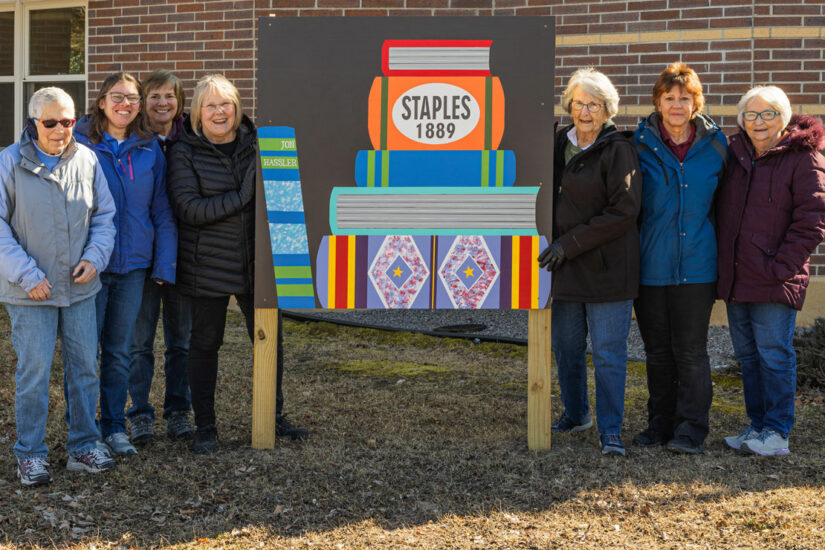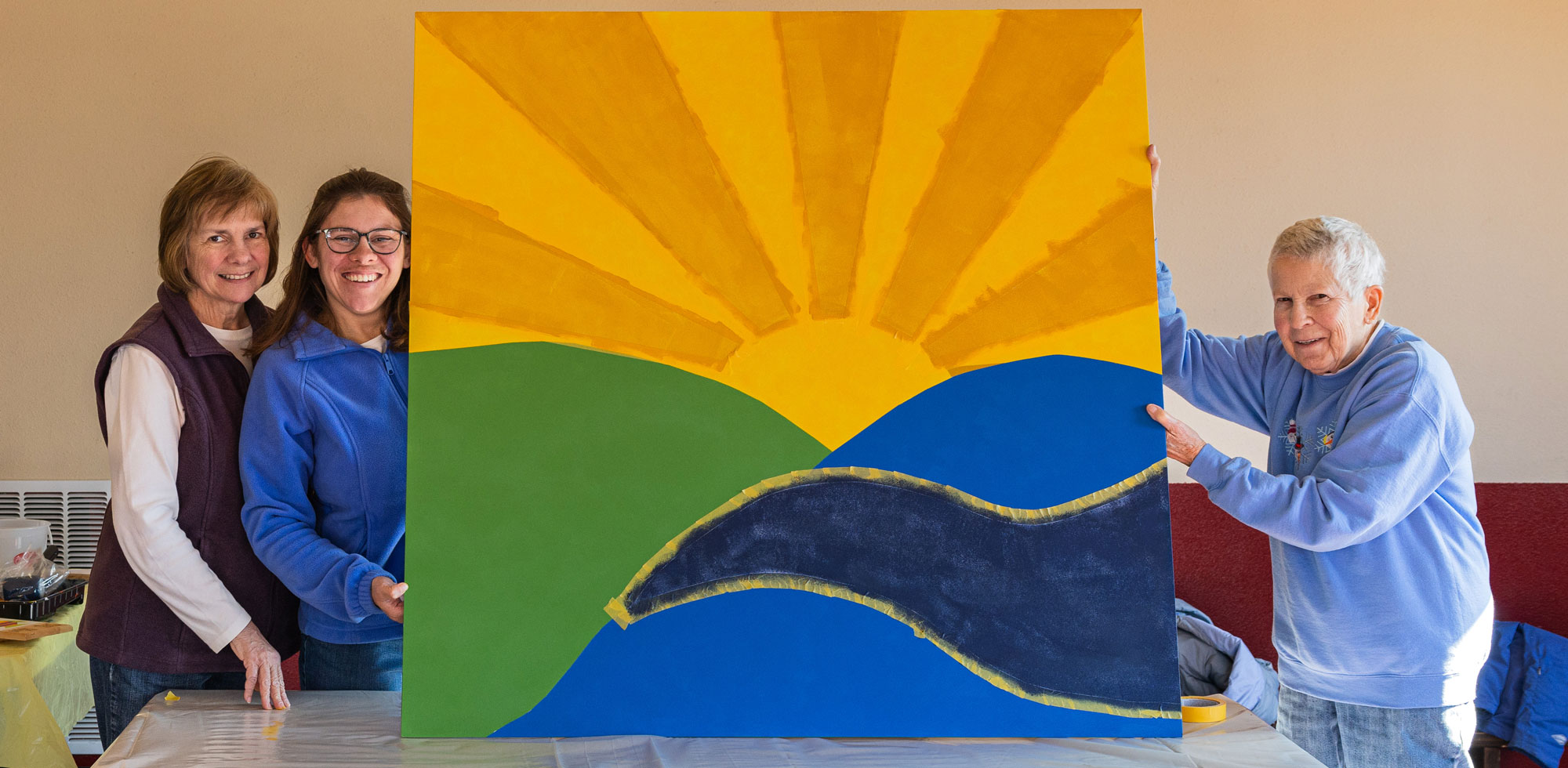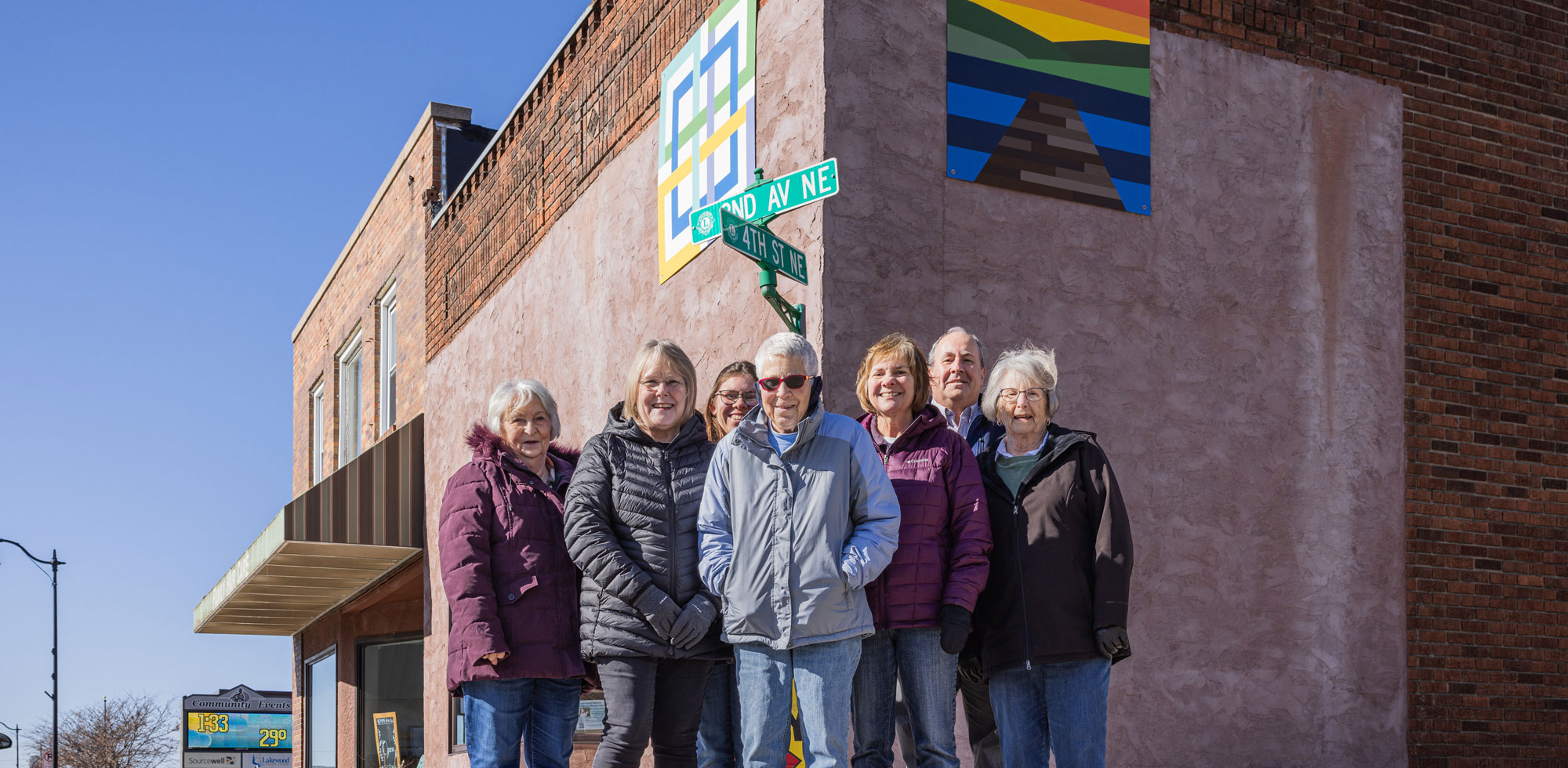
Patchwork of Pride
Central Minnesota Barn Quilt Trail brightens communities, draws visitors, creates connections
By Lisa Meyers McClintick | Photography by John Linn
Against the muted landscape of late winter and early spring, colorfully painted quilt blocks pop out like flowers throughout the community of Staples. A brilliant cardinal graces Mid Minnesota Federal Credit Union. A red-and-blue pinwheel adorns the Staples World newspaper office. At True Hardware, a multi-colored geometric design hints at the number of paint colors inside.
Shape by shape, block by block, the patchwork patterns painted on wood have been multiplying each year since the idea for a Central Minnesota Barn Quilt Trail launched in 2015. The first quilt block was hung in 2016. Organizers are now up to 148 barn quilts, with 54 of them in Staples—the epicenter of this colorful, community-building movement.
“You’re taking something that’s normally found in the home and putting it outside,” said trail co-founder Lisa Kajer. “People love looking at quilts and all the different colors. They bring a smile to your face.”
While it’s hard to numerically track the trail’s economic impact on the region, community leaders say it’s drawing new visitors, connecting people in the towns and rural areas, and enticing travelers to slow down, take a closer look, and maybe stick around for a bite to eat while they plan for a return visit.
Vicki Chepulis, grants and program coordinator at Five Wings Arts Council, has met people in downtown Staples who have come from the Twin Cities to see the barn quilts. Even with COVID-era precautions stalling momentum, the trail has averaged roughly 18 new barn quilts each year since the project started.
“That’s a huge indicator of what it did for the communities here,” Chepulis said.
Trails highlight American folk art
The concept of a barn quilt trail is believed to have begun in Ohio in 2001 and quickly caught on across the country, according to barn quilt expert Susie Parron, who tracks the nation’s trails at barnquiltinfo.com. Wisconsin’s Shawano County claims the country’s biggest barn quilt trail with more than 400 blocks–all 8×8 feet–along its roadways.
Minnesota boasts about eight barn quilt trails. Most stay within the footprint of one county, such as the Chisago Lakes trail with 72 barn quilts near the Twin Cities or the nearly 60 barn quilts in southeastern Minnesota’s Houston County.
“We are the largest geographically,” Kajer said. “We’re the only four-county trail.”
Cass, Todd, Morrison, and Wadena counties were chosen because they each overlap with the Staples-Motley School District, which has played a key role in the quilt trail.
The high school’s Future Farmers of America students put their geometry, drawing, taping and painting skills to work with the first group of barn quilts. After that, art classes took over and have made at least 50 quilts, many for nonprofit and community organizations.
While barns offer the most dramatic backdrop—especially historic red barns—quilt blocks from 2×2 feet to 8×8 feet have popped up everywhere: fire stations, libraries, schools, private homes and even fence posts.
“It’s a very unique opportunity,” said Jill Kneisl, a Staples-Motley art teacher who has guided students in telling a story and working as a team with each barn quilt design. “It’s fun when students come back from different communities and say they have seen their quilt. They are surprised there are so many and how far the trail goes.”
Grant aids maps, more barn quilts
A surge of new barn quilts followed last summer when a $1,700 grant from the Staples-Motley Community Foundation was awarded to LEAP—a Staples-based community group that stands for Leadership, Engagement, Advocacy and Positiveness. The Initiative Foundation hosts the Staples-Motley fund alongside nearly 130 others, giving communities, organizations and individuals the ability to focus on making an impact with their local dollars without worrying about management and administration.
“The target for the project was to get at least six more barn quilts in downtown Staples, making it easier for tourists and residents to find them,” said Kajer. “The more barn quilts you have in an area, the more people you’ll have come to see them.”
Volunteers were able to rent space for five weeks at Faith Lutheran Church, and Kneisl was hired to assist with designs and color-mixing. Fifteen volunteers—more than double what they expected—worked full time for more than a month to create barn quilts while others pitched in with tasks such as delivering finished quilt blocks.
Their efforts amounted to more than $5,000 worth of labor and 11 new barn quilts—nearly double their goal. Visitors can now find a dozen barn quilts within a few blocks downtown and up to three dozen on a longer stroll through Staples.
The other goal of the grant was to make two dozen mini barn quilts that were tucked into city flower boxes. The mini quilts include scannable QR codes that link visitors to Central Minnesota Barn Quilt Trail maps. Marketing cards with maps were distributed to chambers of commerce and travel stops such as hotels.
Online maps help visitors seek favorite designs among the infinite possibilities. Geometric or freestyle patterns reflect businesses, places, or personal stories, making each stop—and each quilt trail—a one-of-a-kind experience.
Staples-Motley Elementary School has a little red schoolhouse design. Dower Lake Park features a fish pattern while Old Wadena Park and Campground on the Crow Wing River sports canoes and paddles. Churches incorporate crosses and rays of light, while eateries get playful. Staples’ Stomping Grounds café chose a quilt block with a cup of coffee while Tower Pizza turned triangles into pizza slices.
Barn quilts can be found in Wadena, Motley, Long Prairie, Sebeka, Bertha, Browerville, and other towns, as well as on barns and businesses on county and township roads. Kajer said they plan to keep adding barn quilts and expanding the trails, especially toward communities such as Little Falls, Pine River and Walker.
“We need to have barn quilts in each of the county seats,” she said. “That would be a goal of ours.”
When quilt trail leaders first sought an arts grant, they weren’t sure the American folk art qualified, said Mark Turner, executive director of Five Wings Arts Council, who considers the public art effort a success and a way to create a sense of place and unity.
“It’s been a bonding experience and a common framework,” he said. “It brings in community, it engages community and artists, and it brings out the artist in everyone.”
MAKING A BARN QUILT
Most barn quilts are made from medium density overlay board or aluminum composite board. Outdoor paint will weather the best, but it’s also possible to use sample paints and seal them for outdoor weather.
Go to barnquiltsmn.org for more tips, info on upcoming workshops, commissioning an artist to make a barn quilt or to be included on the Central Minnesota Barn Quilt Trail. Barn quilts must be visible from public roads, and participants are asked to keep them on display for at least five years.

